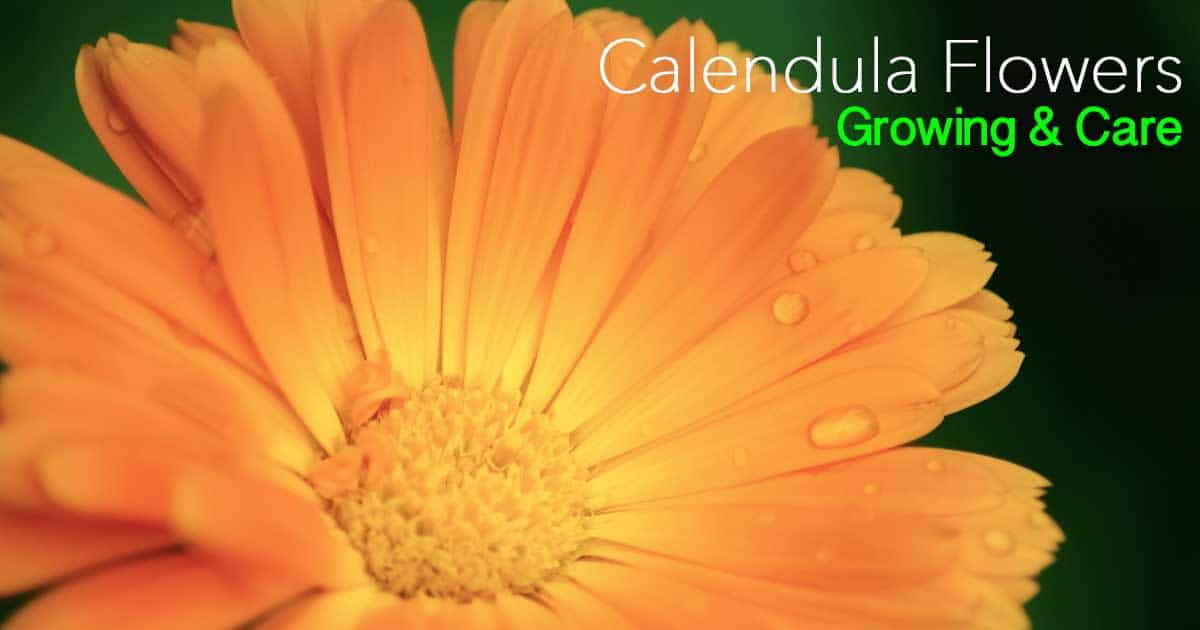Calendula’s or pot marigolds is the botanical name of Calendula officinalis. It also has another botanical name, epithet officinalis, which means used medicinally.
Growing Calendula is easy as long flowering border plants. The Calendula officinalis flowers have shades of yellow and orange with many petals.

Reliable in both wet and dry seasons, this perennial plant in mild climates is treated as an annual in cold climates.
Calendula grows and tolerates a wide variety of soil types but does best in rich, well-drained soil. They bloom quickly from seeds.
The daisy-like often orange flowers mature to a diameter of 2″ 1/2 inches producing a herbaceous fragrance, its edible flowers attract butterflies and bees.
The erect bright green or dark pastel green leaves can grow to a height of 24″ inches tall. Read on to know more about Calendula flower care.
Growing Calendula Plants
When planting Calendula outdoors, sow seeds at a depth of a 1/4 inch (6mm) in early spring.
For hot zones and ones getting little winter frosts (for example USDA Zones 9 to 10) sow seeds in autumn.
In areas with cool summers, plant pot marigold seeds during the summer for autumn blooming.
When starting seedlings indoors under plant lights, begin preparing the Calendula seeds about 8 weeks before planting outdoors after the last frost.
Seeds take 1 to 2 weeks to germinate in the dark at 70° degrees Fahrenheit (21C).
Plant taller Calendula varieties around 20″ inches apart and plant dwarf species approximately 8 inches apart.
Grow them in areas with bright sunlight and in ordinary soil with a ph. of 5.5 to 7.
Caring For Calendula
Choose a full sunny site to grow Calendula. However, plants do appreciate partial shade during hot summer afternoons.
Plants can become leggy if grown in partially shady locations.
Fertilizer Application
Mix 2″ to 4″ inches of compost in the planting soil so as to promote the health of the plant.
Fertilizing Calendulas is not necessary, but adding an all-purpose fertilizer to the soil promotes flowering and vigor.
The recommended amount is 1 to 2 teaspoons of a 16-16-8 fertilizer for each square foot of planting area.
Fertilizers rich in phosphorus will promote flowering.
Watering The Calendula Plant
During the hot weather, give the Calendula s one to one and a half inches of water once a week.
Although the plants can tolerate low-water conditions, irrigating regularly encourages summer blooming.
Calendula Pruning
Pinching back Calendulas promotes a bushier form. Cut them back severely if they begin to suffer in the summer heat.
This helps to keep the plant healthy allows it to recover and produce blooms in the autumn season.
Remove the spent flowers to keep plants looking tidy and encourage additional blooms. Calendula self-seeds quickly and can sometimes become weedy if not deadheaded regularly.
Weeding And Mulching
Pull out any weeds growing near Calendula plants. Apply a layer of 2 to 3 mulch to stop weeds from growing. This also helps maintain consistent soil moisture and keep soil temperatures cool.
You may also like: Marigold Care Information
Pests And Diseases
Regularly inspect the underside of the leaves for pests. Although Calendula’s do not suffer from serious insect problems, it sometimes attracts aphid bugs and whiteflies.
Give the foliage a blast of water from a garden hose to dislodge the pests for starters or try a home remedy for aphids.
Powdery mildew, a fungal disease causes white patches and powdery growth to appear on the foliage of the plant.
Remove any part of the plant affected and dispose of it immediately.
Calendula also experiences attacks of Alternaria blight disease.
Caution: Powdery mildew spreads easily with overhead watering, avoid it if possible.
Calendula Flowers Benefits and Uses
Nowadays, we can use Calendula in many different ways. Many people create products with the use of it like Calendula soap, ointment, essential oils, etc.
Calendula flowers are excellent medicinal plants with incredible healing properties. It has been used for centuries on wounds and skin irritations, to cure sores, dermatitis, burns, and piles.
Also very effective for bee stings. Calendula flower extract includes in some skin soap recipes, lotions, and even bath fizzies.
It can also cure diaper rash, nature’s answer to many skin problems.
Organic Calendula flower petals are used in soups, salads, and stews. The leaves used in decorating cakes and flowers can also be eaten.
Some also make herbal calendula tea. The flowers are used in the cure for stomach ulcers, diseases of the liver, menstrual spasms, and oppilation.
Calendula provides powerful anti-inflammatory activity, antimicrobial, astringent, antifungal, and antiviral properties and is useful in treating a host of maladies and skincare. Calendula cream can also cure varicose veins.
Calendula oil can treat many skin problems and is useful for wound healing. For its many uses and how to make Calendula herbal oil via Mountain Rose Blog
Use Pot Marigold Flowers As A Mosquito Repellent
Calendulas repel mosquitoes with their scent. Plant Calendula in containers near the front or rear doors.
This will help repel mosquitoes in the area. You can also use some cut flowers as decoration for your house.
Place the flowers in a vase and place them in a location you have seen mosquitoes.
Harvesting Tips
Collect Calendula fully open flowers in the late morning hours after the dew has dried. The flowers can be used when fresh or dried and stored for later use.
Cut dried Calendula flower heads and spread them out on a screen, under a dry, shady spot.
Turn the Calendula petals occasionally until they are papery and dry. Store the dried Calendula flowers in canning jars until you need to use the dried flowers.
Varieties of Calendula
- Calendula officinalis – pot marigold, English marigold
- Calendula maderensis – Madeira marigold
- Calendula maritima – sea marigold
- Calendula arvensis – field marigold
